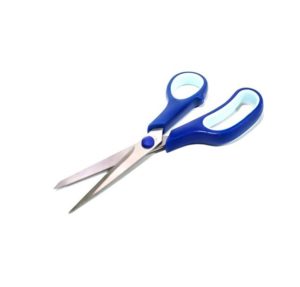Toxic Popcorn Design Challenge
This lesson introduces students to the engineering design process (EDP)—the process engineers use to solve design challenges. Students work in teams to solve the challenge by designing both a product and process to safely remove “toxic” popcorn and save the city.
- Apply the engineering design process to solve a design challenge.
- Build, test, and redesign a prototype.
- Employ teamwork and communication to successfully solve the challenge.
Age Levels: 8 – 18
Build Materials (For each team)
Required Materials
- 60 feet of clothesline (cut into 8 pieces)
- 1 bicycle tire tube 18”- 22” diameter
- 2 containers (32 oz)
- Popcorn kernels (16 oz)
- Round plastic table cover
- Timer (countdown clock)
- Place two containers inside a 4 foot circle. One (unsafe container) is half full of the toxic popcorn. The other (safe) container is available for decontamination. Students must use the available materials to find a way to safely transfer the toxic popcorn from the unsafe container to the safe container
Modification
For ages 9 and younger use marshmallows instead of popcorn. The lighter the material to be transferred the easier the challenge. For ages 14 and older instead of a hula hoop use a circular table cloth 8’ in diameter (or taped down rope). The larger the diameter the more difficult the challenge. Also for older students containers without a lip will be more of a challenge—coffee cans work well.
Design Challenge
You are a team of engineers challenged to save the city from toxic popcorn. A can of highly toxic popcorn has contaminated a circle of approximately 4 feet in diameter. The toxic area extends to the ceiling. If the toxic popcorn is not transferred to a safe container for decontamination within the hour, then it will destroy the entire city. It is up to the team to save the city!
Criteria
- No one may cross the plane of the circle with any part of the body
- No spills are allowed, or the popcorn will explode
- The popcorn and containers cannot cross the plane of the circle (only the ropes & tire tube may cross)
Constraints
- The popcorn must be transferred within 60 minutes or there will be a disaster.
- Use only the material provided
Procedure
- Break class into teams of 4-6.
- Hand out the Toxic Popcorn Design Challenge worksheet, as well as some sheets of paper for sketching designs.
- Discuss the topics in the Background Concepts Section.
- Place two containers inside a 4 foot circle. One (unsafe container) is half full of the toxic popcorn. The other (safe) container is available for decontamination. Students must use the available materials to find a way to safely transfer the toxic popcorn from the unsafe container to the safe container
- Review the Engineering Design Process, Design Challenge, Criteria, Constraints and Materials.
- Instruct students to start brainstorming and sketching their designs.
- Provide each team with their materials.
- Explain that students must transfer toxic popcorn from one container to another within 60 minutes.
- Announce that they have 60 minutes to save the city. They will have 40 minutes to design, build, test, and redesign their solution and the class will have 10 minutes to choose the very best class solution to save the city.
- Use a timer or an on-line stopwatch (count down feature) to ensure you keep on time. (www.online-stopwatch.com/full-screen-stopwatch). Give students regular “time checks” so they stay on task. If they are struggling, ask questions that will lead them to a solution quicker.
- Students meet and develop a plan to transfer the popcorn. They agree on materials they will need, write/draw their plan, and present their plan to the class.
- Teams build their designs.
- Teams should document their process for transferring the popcorn and what materials they used.
- As a class, discuss the student reflection questions.
- For more content on the topic, see the “Digging Deeper” and “Real World Applications” sections.
Student Reflection (engineering notebook)
- Did your solution save the city?
- What went well?
- What didn’t go well?
- What is your favorite step in the engineering design process and why?
- What is your favorite design element and why?
- If you had time to redesign, what changes would you make?
Time Modification
The lesson can be done in as little as 1 class period for older students. However, to help students from feeling rushed and to ensure student success (especially for younger students), split the lesson into two periods giving students more time to brainstorm, test ideas and finalize their design. Conduct the testing and debrief in the next class period.
In order to understand the Engineering Design Process you first need to understand technology and engineering.

Technology is all around us. It is any product (an object created by a person) or process (a series of steps that brings about a result) that is designed by people to solve a problem. Most of the things you are in contact with each day are technology. For example: paperclip, cup, glasses, stapler, bottle, and pencil etc. What technology do you use everyday?
Engineering is the application of science and mathematics to design or redesign technology to solve problems and meet needs. Where scientists study the natural world, engineers design the human-made world. Engineers design everything from sandwich bags to submarines, robots to roller coasters and air bags to artificial hearts! Can you name more technology that

engineers have designed? Check out the Greatest Engineering Achievements of the 20th Century: (www.greatachievements.org) and see how engineers have made the world a better place.
Engineering is a profession with a vast number of disciplines. For example: mechanical engineering, electrical engineering, civil engineering, biomedical engineering, systems engineering, ocean engineering, materials engineering, etc. Can you name more disciplines? To learn more about engineering and the different disciplines, visit www.tryengineering.org.

Engineering Design Process All engineers have one thing in common and that is the process they use to solve problems — it is called the engineering design process. The engineering design process is to engineering what the scientific method is to science.
- Technology: Any product or process that is designed by people to solve a problem.
- Engineers: Inventors and problem-solvers of the world. Twenty-five major specialties are recognized in engineering (see infographic).
- Engineering Design Process (EDP): Process engineers use to solve problems.
- Engineering Habits of Mind (EHM): Six unique ways that engineers think.
- Criteria: Conditions that the design must satisfy like its overall size, etc.
- Constraints: Limitations with material, time, size of team, etc.
- Prototype: A working model of the solution to be tested.
- Iteration: Test & redesign is one iteration. Repeat (multiple iterations).
- Tension: A pull force. Tension is the opposite of compression.
- Compression: A push force. Compression is the opposite of tension.
Internet Connections
- Greatest Engineering Achievements of the 20th Century: greatachievements.org
- NAE Grand Challenges for Engineering: NAE Grand Challenge for Engineering
- Toxic Waste Overview: http://environment.nationalgeographic.com/environment/globalwarming/toxic-waste-overview.html
Recommended Reading
- Engineering the City: How Infrastructure Works (978-1556524196)
- Waste Management (978-1553193074)
Writing Activity
Teams design their product and process only on paper and then pass their “report” (sketches and written description of design and process) to another team to build and test. This activity will reveal if the report was clearly written.
Alignment to Curriculum Frameworks
Note: All lesson plans in this series are aligned to the National Science Education Standards which were produced by the National Research Council and endorsed by the National Science Teachers Association, and if applicable, also to the International Technology Education Association’s Standards for Technological Literacy or the National Council of Teachers of Mathematics’ Principals and Standards for School Mathematics.
National Science Education Standards Grades K-4 (ages 4 – 9)
CONTENT STANDARD E: Science and Technology
As a result of activities, all students should develop
- Abilities to distinguish between natural objects and objects made by humans
National Science Education Standards Grades 5-8 (ages 10 – 14)
CONTENT STANDARD E: Science and Technology
As a result of activities, all students should develop
- Abilities of technological design
- Understandings about science and technology
National Science Education Standards Grades 9-12 (ages 14-18)
CONTENT STANDARD E: Science and Technology
As a result of activities, all students should develop
- Abilities of technological design
- Understandings about science and technology
Standards for Technological Literacy – All Ages
Technology and Society
- Standard 5: Students will develop an understanding of the effects of technology on the environment.
- Standard 7: Students will develop an understanding of the influence of technology on history.
Design
- Standard 10: Students will develop an understanding of the role of troubleshooting, research and development, invention and innovation, and experimentation in problem solving.

Scenario
A can of highly toxic popcorn has contaminated a circle of approximately 4 feet in diameter. The toxic area extends to the ceiling. If the toxic popcorn is not transferred to a safe container for decontamination, then it will contaminate and destroy the entire city. The popcorn is estimated to have a safe life of exactly 60 minutes before it explodes. It’s up to us to save the city!
Design Challenge
Inside the circle you will find two containers. One (unsafe container) is half full of the toxic popcorn. The other (safe) container is available for decontamination. Find a way to safely transfer the toxic popcorn from the unsafe container to the safe container, using only the materials provided to you.
Criteria
1) No one may cross the plane of the circle with any part of the body.
2) The popcorn and containers cannot cross the plane of the circle. Only the ropes & tire tube may cross.
3) No spills are allowed, or the popcorn will explode.
Constraints
1) You may use only the materials provided.
2) The popcorn must be transferred within 60 minutes or there will be a disaster.
Team members:___________________________________________________
Planning Stage
Meet as a team and discuss the problem you need to solve. Then develop and agree on a process for solving the challenge. You’ll need to determine what materials you want to use.
Draw your design below, and be sure to indicate the description and number of parts you plan to use.
Construction Phase
Choose your best product design and your best process design. Build your design. During construction you may decide you need additional materials or that your design needs to change. This is ok – just make a new sketch and revise your materials list.
Testing Phase
Each team will test their design and process. If your design and process were unsuccessful, redesign and test again. Continue until you are happy with your solution. Be sure to watch the tests of the other teams and observe how their different designs worked.
Sketch your Final PRODUCT (make sure to label your sketch):
Sketch your Final PROCESS (make sure to label your sketch):
LIST the STEPS of your PROCESS (be as detailed as possible)
Evaluation Phase
Evaluate your teams’ results, complete the evaluation worksheet, and present your findings to the class.
Use this worksheet to evaluate your team’s results in the Toxic Popcorn Design Challenge Lesson:
1) Did your solution save the city?
2) What went well?
3) What didn’t go well?
4) What is your favorite step in the engineering design process and why?
5) What is your favorite element of your design and why?
6) If you had time to redesign again, what changes would you make?






 Industrial Engineering
Industrial Engineering












